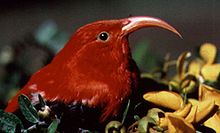Loading AI tools
Subfamily of birds From Wikipedia, the free encyclopedia
Hawaiian honeycreepers are a group of small birds endemic to Hawaiʻi. They are members of the finch family Fringillidae, closely related to the rosefinches (Carpodacus), but many species have evolved features unlike those present in any other finch. Their great morphological diversity is the result of adaptive radiation in an insular environment. Many have been driven to extinction since the first humans arrived in Hawaii, with extinctions increasing over the last two centuries following European discovery of the islands, with habitat destruction and especially invasive species being the main causes.[1][2]
| Hawaiian honeycreeper | |
|---|---|
 | |
| ʻIʻiwi (Drepanis coccinea) | |
| Scientific classification | |
| Domain: | Eukaryota |
| Kingdom: | Animalia |
| Phylum: | Chordata |
| Class: | Aves |
| Order: | Passeriformes |
| Family: | Fringillidae |
| Subfamily: | Carduelinae |
| Genera | |
|
See text | |
| Synonyms | |
|
Drepanididae | |

Before the introduction of molecular phylogenetic techniques, the relationship of the Hawaiian honeycreepers to other bird species was controversial. The honeycreepers were sometimes categorized as a family Drepanididae,[3] other authorities considered them a subfamily, Drepanidinae, of Fringillidae, the finch family. The entire group was also called Drepanidini in treatments where buntings and American sparrows (Passerellidae) were included in the finch family; this term is preferred for just one subgroup of the birds today.[4][5] Most recently, the entire group has been subsumed into the finch subfamily Carduelinae.[2][6]
The Hawaiian honeycreepers are the sister taxon to the Carpodacus rosefinches. Their ancestors are thought to have been from Asia and diverged from Carpodacus about 7.2 million years ago, and they are thought to have first arrived and radiated on the Hawaiian Islands between 5.7-7.2 million years ago, which was roughly the same time that the islands of Ni'ihau and Kauai formed. The lineage of the recently extinct po'ouli (Melamprosops) was the most ancient of the Hawaiian honeycreeper lineages to survive to recent times, diverging about 5.7-5.8 million years ago. The lineage containing Oreomystis and Paroreomyza was the second to diverge, diverging about a million years after the po'ouli's lineage. Most of the other lineages with highly distinctive morphologies are thought to have originated in the mid-late Pliocene, after the formation of Oahu but prior to the formation of Maui. Due to this, Oahu likely played a key role in the formation of diverse morphologies among honeycreepers, allowing for cycles of colonization and speciation between Kauai and Oahu.[7]
A phylogenetic tree of the recent Hawaiian honeycreeper lineages is shown here. Genera or clades with question marks (?) are of controversial or uncertain taxonomic placement.[7][8]
| |||||||||||||||||||||||||||||||||||||||||||||||||||||||||||||||||||||||||||||||||||||||||||||||||
The classification of Paroreomyza and Oreomystis as sister genera and forming the second most basal group is based on genetic and molecular evidence, and has been affirmed by numerous studies; however, when morphological evidence only is used, Paroreomyza is instead the second most basal genus, with Oreomystis being the third most basal genus and more closely allied with the derived Hawaiian honeycreepers, as Oreomystis shares traits with the derived honeycreepers, such as a squared-off tongue and a distinct musty odor, that Paroreomyza does not. This does not align with the genetic evidence supporting Paroreomyza and Oreomystis as sister genera, and it would be seemingly impossible for only Paroreomyza to have lost the distinctive traits but Oreomystis and all core honeycreepers to have retained or convergently evolved them, thus presenting a taxonomic conundrum.[8]
Viridonia (containing the greater ʻamakihi) may be associated with or even synonymous with the genus Aidemedia (containing the prehistoric icterid-like and sickle-billed gapers), and has the most debated taxonomy; it was long classified within the "greater Hemignathus" radiation (a now-paraphyletic grouping containing species formerly lumped within Hemignathus, including Hemignathus, Akialoa, and Chlorodrepanis) and while some sources speculate it as being sister to Chlorodrepanis (containing the lesser ʻamakihis), other sources speculate it may be a sister genus to the genus Loxops (containing the 'akepas, ʻakekeʻe and ʻalawī).[8]
Nearly all species of Hawaiian honeycreepers have been noted as having a unique odor to their plumage, described by many researchers as "rather like that of old canvas tents".[9][10]
Today, the flowers of the native ʻōhiʻa (Metrosideros polymorpha) are favored by a number of nectarivorous honeycreepers. The wide range of bill shapes in this group, from thick, finch-like bills to slender, down-curved bills for probing flowers have arisen through adaptive radiation, where an ancestral finch has evolved to fill a large number of ecological niches. Some 20 species of Hawaiian honeycreeper have become extinct in the recent past, and many more in earlier times, following the arrival of humans who introduced non-native animals (ex: rats, pigs, goats, cows) and converted habitat for agriculture.[11][12]
The term "prehistoric" indicates species that became extinct between the initial human settlement of Hawaiʻi (i.e., from the late 1st millennium AD on) and European contact in 1778.
Subfamily Carduelinae
Hawaiian honeycreepers were formerly classified into three tribes – Hemignathini, Psittirostrini, and Drepanidini – but they are not currently classified as such.
Seamless Wikipedia browsing. On steroids.
Every time you click a link to Wikipedia, Wiktionary or Wikiquote in your browser's search results, it will show the modern Wikiwand interface.
Wikiwand extension is a five stars, simple, with minimum permission required to keep your browsing private, safe and transparent.